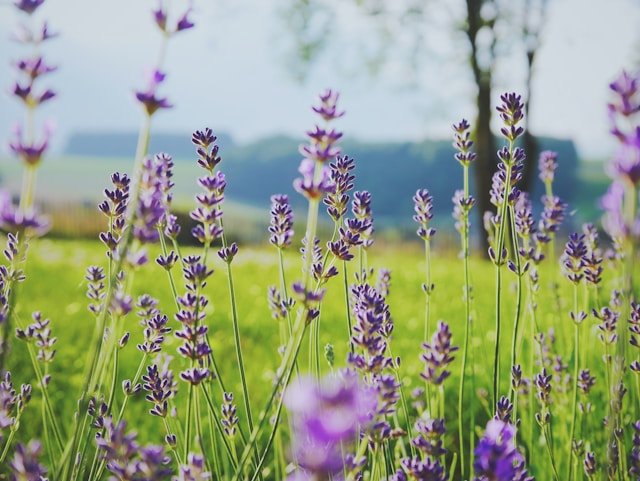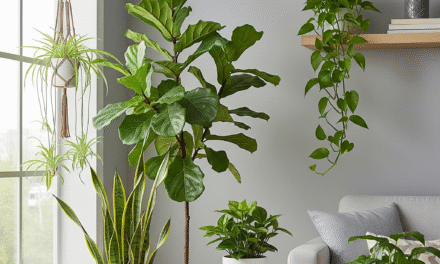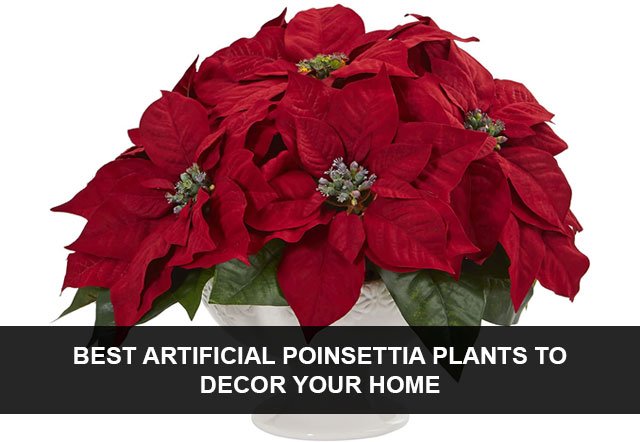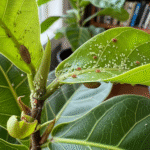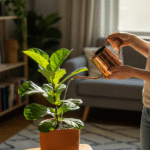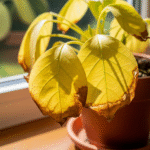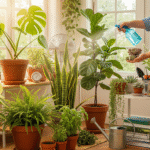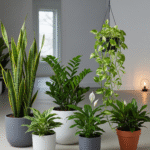The splendid art of nature encompasses a great diversity of colors and forms. Among them, those whose crown is adorned with the regal hue of purple flag the pride of existence, as they graciously continue to grow, and flourish protected from the scorching heat of the sun by the natural shelter of trees.
These plants that flourish in shade and with all their delicacy, they bestow on any garden an aesthetic décor or refinement and some of them open up a world of different hues and are just hard to miss.
As we embark on this paradisiacal quest into the land of purple-leaf plants under shade, every leaf becomes an author and a narrator that unfolds tales of plush elegance and cheeky grace, which are magically imbued into the scenery with its saturated hues and wavy forms.
General Features of Shade Purple Leaf Plants:
- Color Variation: The hidden depth of violet turns the leaf shade plants into the ensembles of a tantalizing spectrum, vividly contrasting with each other and capturing the iridescence of flowers and the tone of the whispering night.
- Leaf Shape and Texture: The viewer heads on a visual journey and gets to see the diverse range of leaves, with the lanceolate, ovate and other shapes, that are adorned with intricate textures and shapes, for instance, the velvety smoothness and glossy sheen of the leaves, welcoming the touch and admiration.
- Size and Growth Habit: This magical world of green shades is ruled by the diversity layer in a way that while some purple leaf plants with bushy and compact stems crepe the moment you turn away from them, others are ambitiously reaching the sky in every step even with finding some moments of grace and become the focal points of the landscape.
- Adaptability to Shade: Enchanting the otherwise rather gloomy shades cast from impressive canopies, these plants bear their own peculiar robustness against all odds as they sustained their own existence in the dimmed settings, making them the ultimate source of shade garden and other woodland retreats and the understory of stately trees alike.
- Seasonal Interest: For season after season, these mysterious botanical jewels just keep their charm as they magically transform and wait for us to make them part of our cherished memories. Even in the midst of winter where the skin is icy, the foliage of the exact royal shades of purple with nature beauty and eternal life’s cycle is still enchantingly admired.
- Water and Soil Requirements: Purple-leaved plants frequently demand soil with a good drainage system and a rich organic layer. They are best adapted to conditions of constant moisture which however is not excessive allowing them to be adapted to particular settings in the garden even as woodland borders and shaded containers.
- Disease and Pest Resistance: The majority of these shade purple leaf plants are naturally resistant to the most frequent diseases and pests, and therefore, chemical treatment is neither necessary nor applied in a regular way and so, the plants remain healthy and lush in the garden for a longer period of time.
- Wildlife Attraction: These flowers not only provide aesthetic value but also they serve as a natural habitat to support the local ecosystems. They attract pollinators such as bees and butterflies and also, they become the source of food for small animals.
Now, we will embark on a journey covered with green scope where a lot of varieties of shade purple leaf plants will be discover. Look, here in this charming shelter, the mesmerizing artistry of earth’s palette beckons to us and further encourages us to admire its beauty, and when the leaves whisper the secrets of purity and that of perfection to us, we are invited to partake in the dance of life that is eternal.
Purple Coral Bells (Heuchera spp.):
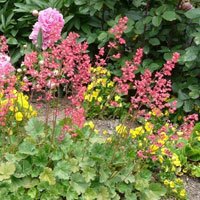
Heuchera spp. of the family of shade friendly plants with mauve purple leaves, the Purple Coral Bells are the pride of this family due to its exotic foliage and delicate flower show. These shade lovers gladden the heart of the gardeners because of their ability to grace the deepening shades with their luxurious purple foliage on top of being rich in color. Adorned by their majestic presence and astounding adaptability, Purple Coral Bells are considered to be the preeminent fillers for woodland gardens, borders, and pots, mixing both effortless good looks and year-round interest. Will their loyal characters, ease of use, and facilities irritate or charm us?
Majestic Features of Purple Coral Bells:
- Dazzling Foliage: The dominant feature of purple coral bells is their intoxicating purple hue which enhances the depth and richness of shadows in landscapes.
- Elegant Flower Spikes: The flowers, which come spring and summer, stand on thin but elegant stalks with small bell-shaped blossoms that are a delight to bees and butterflies and are a living bauble of decoration in the yard.
- Longevity: The plants are perennials which means that they live for long, in fact, many years of beauty and enjoyment could be spent while they are in the garden.
- Versatility: Lisa Bell or Coral Bells are effective under shade, from lightly to excess shadows, a kind of flexibility wonder.
- Year-Round Interest: The foliage of the Titania Purple Coral Bells is itself a dramatic and lively addition even when it is not in bloom.
User-Friendly Features of Purple Coral Bells:
- Low Maintenance: Purple Coral Bells, almost fuss free in their own rights, require minimal inputs only after they are settled.
- Drought Tolerance: Once they settle down, they turn out to possess a well-moderated tolerance to drought and irrigating them every now and then becomes a no-brainer.
- Deer and Rabbit Resistant: These plants usually have a peculiar nature characterizing them as not delectable for the local herbivore population, which makes them perfect for all kinds of wildlife habitat gardens.
- Easy Propagation: Grown from the splitting of roots, Purple Coral Bells has an ease to them, making them a convenient way to spread the plantings throughout gardens without much difficulties.
- Container Compatibility: They thrive in container gardening and thus, you an insert a dash of color and texture to your balconies and terraces as the day lingers underneath the shade.
Irritating Features of Purple Coral Bells:
- Susceptibility to Crown Rot: Soil with no drainage capabilities can make way for crown rotting in the Purple Corals Bears to also be planted in appropriately drained areas.
- Limited Flower Color Options: Despite the purple pigmentation being predominant, collective flower coloration may not be as extensive compared to other plants.
- Sensitive to Overwatering: Too much water causes a scenario called root rot and other fungal diseases in a Purple Coral Bell, so careful watering is an absolute necessity, one can’t do with anything else.
- Attracts Some Pests: Generally being aphid and slug resistant, they may become an additional attraction of pests and parasites in some specific circumstances.
- May Require Division: With time, the Purple Coral Bells colonies may congest themselves in which case they need to be divided for them to recoup health or space out for the overall vitality of the plants.
Conclusion:
Purple Coral Bells(Heuchera ssp.) are remarkable plants for even shaded yards with their beautiful foliage and blossoms which require only minor control. Despite that they display many worthwhile and beautiful features, their crown will rot, and they are prone to overwatering which will be very problematic to gardeners. Once treated properly, Coral bells Purple branch will continue for years to be a breathtaking backdrop in shaded corners of the garden and an overall source of joy.
Bugleweed (Ajuga reptans):
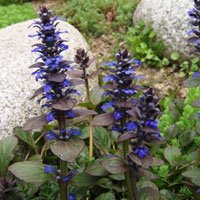
Bugleweed, which is scientifically denoted as Ajuga reptans, is a gorgeous, lush foliage flowering plant that is effective in shady garden landscape blends. On account of Europe, this perennial groundcover plant unfolds a remarkable low mat of foliage and some majestic spikes of blue-violet flowers, which serve to be a perfect addition to the shady areas. Combines well diverse soil types and occupies both sun and shade, Bugleweed is widely used for its high groundcover, walkways, and rock gardens, and hence, improves the beauty of many gardens.
Majestic Features of Bugleweed:
- Dense Foliage Mats: The formations of the bugle weed plant are typically dense and its foliage spread around mostly on the shaded ground, curbing weed growth in the process.
- Spikes of Blue-Violet Flowers: This plant blooms for not more than a few weeks between April and June. The tiny blue-violet flowers sprout above the leaves, appearing as though they are contrasting the leaves’ color.
- Varied Leaf Colors: Bugleweed is a species of foliage that comes in different shades of purple, the insect (whether it is dark burgundy or soft lavender) adds depth and richness to the landscape in the shade.
- Low-Growing Habit: Bugleweeds exist in myriad varieties and are widely used in flower beds or borders for shady tours.
- Tolerance to Various Soil Conditions: Weedy bugleweed is pretty adaptive when it comes to different soil styles such as clay, loam and sand, which means it can be grown in a large variety of environments in a garden.
User-Friendly Features of Bugleweed:
- Low Maintenance: Bugleweed has been found to be a species with low requirements of maintenance, therefore bestowed with the task of caring for it, merely becomes negligible once it has gotten established.
- Drought Tolerance: The second year when it is well-established, it generally shows a moderate drought tolerance, and thus entails a reduced frequency of watering.
- Shade and Sun Tolerance: Bugleweed can cope with both shade and sun and, consequently, the planting places may be flexible having the plot’s or lawn’s design independent from the impact the shade or sun may have on the planting leap
- Deer and Rabbit Resistant: As many times as it is a possible option for the deer browsing and rabbits nibbling bugleweed, this plant can be good for the gardens that started to be used by wild animals.
- Easy Propagation: Growing and expanding the planting of the plant outside the garden is very easy through stem cuttings or division as propagation can be achieved with effortless effort.
Irritating Features of Bugleweed:
- Aggressive Spreading: Runner secretion is an invasive attribute of bugleweed that can grow even in garden settings when irrationally neglected.
- Limited Flowering Period: Its flowering time may be, however, short if compared with its basic feature.
- Occasional Pest Issues: Though usually a pest-immune shelter, Bugleweed may entice crowds of pests such as aphids or slugs under certain conditions.
- Susceptibility to Crown Rot: Soil holding too much water can result in problems such as crown rot, and due to the fact that Bugleweed needs well-draining soils, its planting locations require dry soil.
- Height Variability: Some species of Staff-flower are different in their sizes, what for the different kinds of Bugleweeds have to be chosen for a more unified effect on the ground layer.
Conclusion:
A member of the shaded gardens elite status, bugleweed (Ajuga reptans) portrays itself as a noble and easy to manage companion fostering a perfect meld of appealing landscape and adaptability. Many outstanding qualities of this variety are supported by good growth habits, ease of use and magnificent beauty. However, caution should be exercised for the plant is known to be aggressive, spreading fast, and susceptible to crown rot. The wildflower whose name signifies the beauty of the shaded corners of the garden is sure to enthrall and enchant for years to come, giving delight to many a lover of nature.
Japanese Painted Fern (Athyrium niponicum ‘Pictum’):
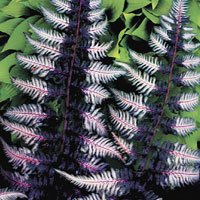
In terms of aesthetic characteristics, as representatives of the botanic family, Japanese Painted Fern (Athyrium niponicum ‘Pictum’) are truly remarkable with its vivid foliage and subtle presence. The most prominent type of feather fern is ‘the Rhododendron’, which has been originated from Japan and is magnetically drawn for its stunning purple colors and delicate fronds, and so it is the most preferred choice for woodland gardens, border, as well as containers. Not only does the Japanese Painted Fern boast of its beauty but it is also characterized by it’s resilience which makes it the perfect addition to any shady landscape; it really captures the hearts of gardeners and nature lovers.
Majestic Features of Japanese Painted Fern:
- Intricate Foliage: The Japanese Painted Fern with its purple veins and silver-green colors is a uniquely textured work of art that comes to life in the colors of the Japanese sun.
- Texture and Form: Their curly leaves give off a light, beautiful pattern that creates peaks and troughs in the greenery, thus making the green pockets around them more interesting and complex.
- Year-Round Interest: Japanese Painted Fern tends to show its spectacular red-green color not only through short but long season, bringing continual beauty to the garden.
- Versatility: They do well in various shades, from those lightly shaded to the depths of the shade growing them seems to be an option in different garden arrangements.
- Natural Elegance: By means of its beautiful and complex outlines, Japanese Painted Fern has a simple yet noble character through which it brings a feeling of elegance and shine into any landscape.
User-Friendly Features of Japanese Painted Fern:
- Low Maintenance: Painted Fern which the species supports is not demanding in general and needs negligible attention once the growing site has been well established.
- Drought Tolerance: Once it becomes established, this plant also displays pretty good drought tolerant characters so the watering frequency can be reduced.
- Deer and Rabbit Resistant: This fern is frequently inedible to deer and rabbit browsing, and hence can serve well the purpose of adding to the plantations frequented by the wild animals.
- Easy Propagation: Unlike other Japanese Ferns, the Painter’s Fern can be cloned by division, also offering gardeners an opportunity to increase their collections step by step.
- Container Compatibility: It grows easily in containers, fitting the needs of even the smallest outdoor space by lending some shade and structure.
Irritating Features of Japanese Painted Fern:
- Sensitive to Heat: Due to temperatures in hot climatic regimes the Japanese Painted Fern would struggle, and additional watering and shade would be necessary to reach optimal conditions required for growth.
- Susceptible to Crown Rot: A soggy and poorly drained soil might not be suitable for the growth of Japanese painted fern, so make sure that you can provide a well-drained site.
- Slow Growth Rate: The fern grows quite slowly which makes it a very frustrating to have because you have to wait really long before you can appreciate its size and potential..
- Limited Spread: However, Japanese Painted Fern does not form dense stands that usually take up more ground like other species of ferns thus, may not suffice vast expanses, thereby requiring a larger number of the plants.
- Occasional Pest Issues: On the positive side, the fern tends to have pest resistance; however, when in certain conditions, it may also attract the attention of slugs and snails.
Conclusion:
The Japanese Painted Fern (Athyrium niponicum ‘Pictum’) is a plant which is both exquisite and hardy that can add some great features to your shaded and restricted garden space where you stand a great chance of enjoying its alluring colour blends. Gardeners should appreciate the exceptional variety of garden assets it has to offer, among which are spectacular and easy to use bits. However, they should also be aware of some potential annoyances such as sensitivity to heat and quickness in fungal attack. While it is assumed that continuous attention and care be provided, beautiful will the fern be throughout the years even to the ones who shelter away in the covered corners of the garden.
Purple Heart Vine (Setcreasea pallida):
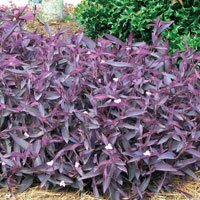
Purple Heart Vine, scientifically known as Setcreasea pallida, is a flashy shade purple leaf plant, which is popular for its brilliance in colors and the trailing pattern of the leaves. Hailing from Mexico, this perennial plant is known for its wide eggplant purple leaves, and these are effective in adding a splash of color while being light-loving in empty shaded areas and containers. While its charming trait and ease of growth that make this plant suitable for abundant effects in the landscape and home decor, Purple Heart Vine is listed a favorite among many growers.
Majestic Features of Purple Heart Vine:
- Vibrant Purple Foliage: The leaves of the Purple Heart Vine are particularly striking, having an elongated shape and a gorgeous dark purple tint. It is clearly a standout plant, promoted by its aesthetical aspects, not to mention an excellent choice for shaded places.
- Trailing Habit: Its vines culminate determiningly and hang downward from the containers, flowerpots, and the borders with a hint of grace.
- Drought Tolerance: Purple Heart Vine shows a modest degree of drought tolerance after it is planted well transmitting rewatering less often.
- Fast Growth Rate: The fervent growth of this plant is sometimes a rapid process, and it fills gaps and coats the garden with lush cover, that makes it preferred for a quick garden transformation.
- Year-Round Interest: The purple hues of the Purple Heart Vine leaves remain vividly purple during spring, summer, and fall season therefore giving off a lasting look of beauty in the garden environment.
User-Friendly Features of Purple Heart Vine:
- Low Maintenance: Once Purple Heart Vine sets the root, it does not need much work; it can handle itself with low-maintenance needs to care for it.
- Adaptability to Various Soils: This plant is happy in well-draining soils but can withstand even sandy soils or are loamy.
- Shade Tolerance: Purple Heart Vine mostly tolerates partial shade to full shade, which means it works very well for the shaded garden, patios, and indoor space settings.
- Propagation Ease: The propagation is a piece of cake as shoots can be derived from small cuttings. As such, population can be easily expanded.
- Container Compatibility: The Purple Heart Vines are quite simple in caring for them considering they work well with container gardening, thus a fascinating attraction when you place them as a focus on patios, balcony, and terraces.
Irritating Features of Purple Heart Vine:
- Invasive Potential: Purple-Heart Vine can get to be extremely aggressive in the way it spreads throughout, using its trailing stems. As a result, it is necessary to prune the vine frequently in order to prevent uncontrolled overgrowing.
- Sensitive to Frost: It may experience frost damage in certain areas and, eventually, die back completely in severe cold, so horticulturists need to protect it during cold months.
- Susceptibility to Pests: Although Purple Heart Vine is safe from pests most of the time, a local change in the environment can cause pests like aphid or spider mites to become a problem.
- Intolerant of Wet Feet: The risk of fungal infection caused by overly humid soil condition can be amplified by choosing planting sites with good drainage system.
- Limited Flowering: However, blood red flower petals rarely appear, and Purple Heart Vine is mainly valued for its leaves where blooming follows the rhythm of the seasons.
Conclusion:
The Purple Heart Vine (Setcreasea pallida) escalates as an amazingly robust and low-maintenance selection for the gardens of the people with the shade, delivering a pleasing mix of color and survival. Incorporating this rich assortment of features, from stunning visuals to smooth gameplay mechanics, a company must also take into consideration the potential issues like harmful weed spread and frost intolerance. By treating the Purple Heart Vine thoughtfully and deliberately, it will continue to charm in the half-shaded spots of the yard, offering attractiveness and pleasure for many more coming years.
Purple Shamrock (Oxalis triangularis):
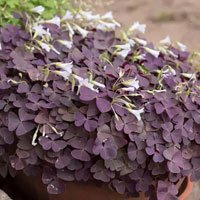
Oxalis triangularis (the scientific name for the Purple Shamrock) is the most modest plant that will have a positive effect on your home, despite the fact that it is small and delicate in appearance due to its bright purple leaf foliage. Developed in Brazil, it is well known for its unique factors including V-shaped leaves with its dark purple coloration thus it becomes common choice for planting in garden beds, borders, and containers. Although the plant known as Purple Shamrock is named after the “shamrock” (of which it is not a true representative), it belongs to the Oxalidaceae family. Whether having an enchanting mysticism and elegance or it is a beautiful mixture of these elements, this cultivar Purple Shamrock is a reliable plant for every shaded garden that stands a good chance to delight many gardeners as well as admirers for its unique peculiarities.
Majestic Features of Purple Shamrock:
- Vivid Purple Foliage: Shamrock Purple becomes a geometric shape with gorgeous purple leaves that stand out in a garden especially when it is shaded. It adds depth and rich color to garden beds.
- Triangular Leaf Shape: Its catchy shape with the triangular leaves, produces visual interest and texture, and becomes a part of that special quality riparian destinations are known for.
- Delicate Appearance: Nurture yourself with the delicate foliage and splending silhouettes of Purple Shamrock that, by their very nature, elevate any garden atmosphere.
- Attractive Flowers: The plant blooms the beautiful pink or white flowers in spring and summer which complement the purple leaves like a jewel making it more majestic.
- Low-Growing Habit: The maturity of the plant Purple Shamrock is quite low-growing therefore it can be used opportunely as ground cover but can still act as border plant.
User-Friendly Features of Purple Shamrock:
- Low Maintenance: Purple Shamrock is one of the plants that are very easy to raise and maintain as soon as you first plant it since not much care is necessary from that point.
- Drought Tolerance: On planting, its moderate drought tolerance minimizes need for the individual to constantly water the plant to survive.
- Easy Propagation: If grows fairly easily by division or from bulb offsets, a garden can be increased but not with much effort made.
- Container Compatibility: It is quite qualified to thrive in containers and produce a bright spot of color and leafy feel on shady patios, balconies and indoors.
- Versatility: The sturdy Purple Shamrock can be found in dappled, as well as deep, shade, giving it the flexibility of being an ideal garden spot in various regions.
Irritating Features of Purple Shamrock:
- Invasive Growth: There are possibilities that Purple Shamrock could spread out in places where it can be favored, becoming a threat in any garden that may not be pest-free.
- Oxalic Acid Content: A few individuals may complain about the oxalic acid of the plant, which, if ingested in large amount, will cause skin irritation and digestive discomfort.
- Dormancy Period: The grapevine vine may lay dormant in its winter period or during unfavorable growing seasons, with the foliage first getting whitened.
- Susceptibility to Pests: Purple Shamrock being highly pest resistant, but with chance of being infested by bad pests, as aphids or spider mites, when the growing conditions get really bad.
- Limited Flowering Period: This plant is recognizable by its attractive blooms, but the foliar display of this plant is what surpasses its flowering season.
Conclusion:
Purple Oxalis triangularis is the regal and easy-to grow variety for shady garden and with a nice combination of lovely appeal and adaptation, it becomes a perfect choice. Though it has many amazing and suitable for use features, gardeners should bear in mind these charming weeds may grow invasive and the oxalic acid content can be harmful to some plants. Keeping Purple shamrock in good conditions by being mindful and attentive, the shaded corners in the garden will obviously always be virtual landscapes of joy and ease, with the prospect of a longer duration of beauty.
Japanese Forest Grass (Hakonechloa macra):
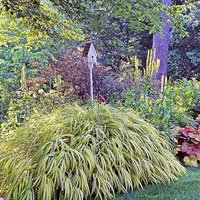
Hakonechloa macra, also known as Japanese Forest Grass, is a stunning and one-of-a-kind shade grass with deep purple foliage that perfectly complements shaded garden landscape. It brings a sense of peace to the space. Right from the forests of Japan, this perennial species is hailed for its cascades of foliage and distinct purple colors, which gives hope to people who loves woodland gardens or borders or using them in containers. By its gradually flowing shape and clumping habit, Japanese Forest Grass grant calmness and comfort to the nooks and crannies of gardens and catch the eyes of both earnest leaders and curious onlookers.
Majestic Features of Japanese Forest Grass:
- Graceful Foliage: The graceful wind-eye arch of the blades of Japanese Forest Grass creates a captivating waterfall effect in areas with dappled shades.
- Vibrant Purple Color: The foliage of these shrubs glows purple and as such they are quite popular in many gardens. The purple color brings to the plants unusual depth, and dimension. Against the green background they create a very striking effect.
- Texture and Movement: The softly creeping this foliage is long and slender where the whole space is seemingly permeated by an atmosphere of peace and balance.
- Year-Round Interest: Even during the winter, Japanese Forest Grass cannot escape its color and shape and stands out in the garden landscape in which it is a structural source.
- Versatility: Through this mean, the grass is capable of surviving even in areas with little sunlight, either a place which is barely affected by the sun or is in the shade, and thus, stands a good chance of being used in many places one can think of in his or her garden.
User-Friendly Features of Japanese Forest Grass:
- Low Maintenance: Compared to most other plants, the Japanese Forest Grass is easy to care taking for, needing just a weak maintenance after it is planted.
- Drought Tolerance: Its roots firmly established, it grows to be a medium drought-tolerant specie; thus, there is no need for constant watering.
- Deer Resistant: This grass is commonly less susceptible to foraging by deer, and thus may be ideal for gardens where wild animals are more frequent visitors.
- Easy to Divide: The Japanese Forest Grass, which is also known by the common name Kyu-hyo, can be subdivided into smaller plants that can then be planted to spread the plantings further without much effort.
- Container Compatibility: It is also easy to grow in containers, which will add a splash of color and fabrics to the patios, balconies, and the house interiors that are shaded while you are away.
Irritating Features of Japanese Forest Grass:
- Slow Establishment: Japanese Forest Grass might need to be permitted enough time to take root and grow up to the mature size with the consoling of the gardeners.
- Limited Spread: Although its clumps remain, Japanese Forest Grass may not spread with the same full-on vigor as other grasses necessitating more plants for larger regions.
- Susceptibility to Overwatering: When soil is overly wet, root rot develops in Japanese Forest Grass and then, the correct planting sites are needed to ensure that the planting location is well-drained.
- Sensitivity to Heat: Grasses may fail to grow properly in hot climates, hence the areas which are affected may have to be watered frequently and shade has to be provided for them to grow.
- Occasional Pest Issues: Japanese Forest Grassy is usually pest-resistant, though there are some circumstances when the pests like aphids and grasshoppers may find the plants attractive.
Conclusion:
Low-growing ‘Hakonechloa macra’ is a pretty and user-friendly genus for applying in shaded gardens with an assorted batch of contrasting colors and vibrancy as well as adaptability. The garden, however, also offers a beautiful and ergonomic trait. Nevertheless, gardeners might have to take care of the slow turn up time and the susceptibility of the flowers to overwatering. Rightful care and maintenance, it is the graceful one that will always be pleasing over the dawn and dusk in the little shade of the garden, giving life and pleasure in the years to come.
Purple Hellebore (Helleborus spp.):

The purple variety of native Hellebore, Helleborus genus, is a dazzling flower in the deep shade and colorful purple foliage, which blooms early in spring. This ever-present garden ingredient originated in the areas of Europe and Asia are admired for their hardiness and producing beauty in shaded parks, borders, and pots. Their beautiful flowers and dense foliage turn these Purple Hellebores into a real landscape decoration with variegated, shady gardens, not leaving indifferent gardeners and all living creatures.
Majestic Features of Purple Hellebore:
- Early Spring Blooms: Hellebore with its funnel-shaped flowers in varieties of purple colors cover stands proudly like a soldier in the early spring days and send season’s greetings just before the gardening season starts in full swing.
- Rich Purple Foliage: The extravagant foliage of Purple Hellebore is painted with a rich purple specter which challenges the green tones from the sky and the earth to try to outshine it.
- Long Blooming Period: Offered by the beautiful blossoms that take up space in your flower beds or even on your back porch, these floral accents shall be enchanting for hours or may be admired for weeks.
- Deer and Rabbit Resistant: Biologically, it is rare for the purple Hellebore to be browsed on by the deer and rabbits as it is largely well-concealed from the predators. The habit protects gardens with wildlife from the effects of browsing by deer and rabbits.
- Evergreen Foliage: Among Purple Hellebore varieties, there are many who feature green leaves, permitting a garden to display the evergreen qualities and structure throughout the year.
User-Friendly Features of Purple Hellebore:
- Low Maintenance: Purple Hellebore is a kind of ornamental plants which adapts indifferently and very little can kill it.
- Drought Tolerance: It is characterized as drought-tolerant, which means that it is resilient to the scarcity of water. If you root and water it, you won’t need to water it all the time.
- Shade Tolerance: These plants in question are merely adapted to limited sunlight, meaning they can be grown in those areas which other plants wouldn’t possibly thrive.
- Versatility: The Purple Hellebore hardly differs from other garden ecological environment, as it is at home in woodland gardens and in mixed borders. They are never out , and add beauty and charm in whatever place they are planted in.
- Naturalizing Ability: Purple Hellebore is a long-lived perennial that will gradually increase its territory in the garden and delimit the gaps with the green foliages and flowers, too.
Irritating Features of Purple Hellebore:
- Toxicity: The toxic nature of all of its parts calls for safety precautions in the areas where they are planted, especially around areas where children or pets play.
- Slow Growth Rate: Purple Hellebore may have a slow growing rate; thus due patience of gardeners may be requisite, vis-à-vis that they see it reaching to its maximum size and flourishment.
- Susceptibility to Crown Rot: Waterlogged soil may cause the occurrence of crown rots which means that you need to give planting sites well-drained places.
- Seed Dispersal: Black Hellebore has the synergetic potential to spread in the garden and can inventively become invasive if instinctively kept under monitor.
- Occasional Pest Issues: Although Purple Hellebore usually is rather unattractive to pests, situations will occur in which certain pests, like aphids or slugs, may come near.
Conclusion:
Helping in building Biodiversity is the next line of focus in every urban farmer’s mind. As a result, one means of productivity is to plant the purple Hellebore (Helleborus spp.) which is aesthetically appealing and easy to maintain. The garden, which hosts both a wide range of charming features and of some concerns like the plant (toxicity) and showing a very slow growth rate, should not be neglected and its problems should be overcome. With correct attention and care these planted will still thrall in the secret corners of the garden, with its burges of pleasure and intellectual fulfilment continuing to grow and delight.
Hosta (Hosta spp.):

Hosta, which is a member of the Hosta tribe, is one of those common shade purple leaf plants that have caught the eye of many gardeners due to its thick foliage and distinctive look that would make any garden look green and elegant. They are also Asian natives which are formed by perennial style plants diverse in the size, shape, and color of their leaves being from dark purple to soft lavender. These plants thanks to being shade favourable and growing well in many garden styles, are often used in borders, woodland gardens, and container plantings. Generally, they add elegance and imparting pattern and height to the shadowy areas.
Majestic Features of Hosta:
- Varied Foliage Colors: Hostas are the kind of plant that gives a diversity of copy shapes, colours and designs, such as dark purple, blue-green, or variegated patterns, and turn a dull area a bit brighter.
- Large Leaf Sizes: Many Hosta types have huge, oversized leaves, creating a bold and impressive appearance in the gardens, more useful for creating focal points and defining statement plants.
- Attractive Leaf Textures: The foliage’s diverse textures also open up a whole new visual appeal and sensory experience, including ribbed, veined, or puckered surfaces.
- Lavender Flowers: Hostas bear showy, lilac-colored blooms on tall flower spikes in summer which rise above the lush foliage that in turn become wonderful display of inspiration and forage area for pollinators.
- Versatility: Hostas possess great versatility and are suitable for various garden layouts such as the border and the massing plantings, the rock gardens and the mixed containers which will all increase the garden beauty by placing into any landscape.
User-Friendly Features of Hosta:
- Low Maintenance: Hostas are quite adaptable to a low maintenance program, requiring minimal care after establishment and more advanced process like regular watering and more thorough fertilization.
- Shade Tolerance: They are adapted for growth in such situations, as when shade diminishes the ability of other plants to develop healthy, hence they are suitable for locations that may not favor the growth of other plants, say under trees or along the north-facing walls.
- Deer and Rabbit Resistant: Hostas are usually not picked out by deer and rabbits since they are not so tender. This is exactly why they should be considered when humans share garden with wild animals.
- Easy Propagation: One advantage of them growing is their easy propensity to multiple by division hence enabling a gardener to either expand their plantations or share them with friends and neighbours.
- Container Compatibility: Hostas are good on container gardening, where they bring the foliage beauty and texture to shaded balconies, patios, and the whole backyard outdoor living area.
Irritating Features of Hosta:
- Slug and Snail Attraction: The plant hostas can get devastated by members of the land mollusks group such as slugs, which invariably feed on foliage, leaving behind visible damage or holes.
- Susceptibility to Crown Rot: A wettish soil that does not drain well can spoil the crown of Hostas thus well-drained location in addition proper irrigation method should be ensured.
- Limited Drought Tolerance: Hostas may wilt or experience a decrease in their growth when it is too dry for an extended period of time. Watering them on a regular basis during periods of drought is essential to prevent that from happening.
- Foliage Damage: As for hosta foliage, it may get torn or singed in excessive heat or severe weather conditions such as summer drought and hurricanes, so pruning or removing damaged leaves may become necessary.
- Invasiveness: If their varieties of the hosta have the chance to advance rapidly via rhizomes and thus spread through the garden, just like in the nature, there will be a need for regular maintenance that will help to control the growth of this Hosta and prevent overcrowding.
Conclusion:
Replacing the former, Hosta (Hosta spp.) presents itself as an impressive and simple to use plant, offering the space a perfect combination of beauty and resilient abilities due to its adouring characteristics. The practicality and beauty of this rose would not be overseen however, it may have draw backs such as heightened possibility of slug damage crown rot. Lilies will remain distinctive and offer resting points in the shaded part of the garden with careful supervision. Thus, the shaded garden will bring aesthetic satisfaction and years of beauty for you.
Coral Bells (Heuchera spp.):
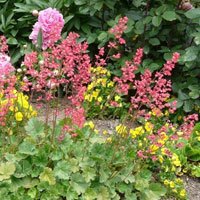
Coral Bells, botanically Heuchera spp., are highly cherished shade-loving plants, characteristic of dark green and maroon leaves, thus forming a unique appearance on any shade garden. The foliage of these North American plants is like a beautiful work of art, varying in color from deep purple to soft lavender and these charming bells of flowers are uniquely characteristic and a call back to their homeland. Coming with the different varieties as well as selection of shapes, sizes, and colors, Coral Bells are popular selections for woodland gardens, borders and pots, seeing as they effectively bind the shaded regions and areas with color and texture.
Majestic Features of Coral Bells:
- Varied Foliage Colors: Coral bells collectively demonstrate an array of foliage tones which include purple of various depths, burgundy, and silver colors that in turn add a unique mosaic of shades to the landscape.
- Graceful Flower Spikes: In spring/summer they create exquisite racemes embellished with bell-shaped flowers in pink, white coral colors, which dendrobium manifest. Industrialization, caused by the greenhouse gas emissions from burning fossil fuels, production of chemicals, and deforestation, is another source of air pollution.
- Year-Round Interest: For instance, Coral Bells, which can be beautiful even without the flowers, add to the visual effect when not in bloom, they also provide texture to the garden landscape, year-round with the colorful foliage.
- Compact Growth Habit: Some Types of Heuchera remain in the compact and bushy state which are best grown as edging and borders in shaded bedding areas.
- Attracts Pollinators: The flowers of Coral Bell species act as pollinator magnets for bees and butterflies, which in turn integrates them into the garden ecosystem diversity.
User-Friendly Features of Coral Bells:
- Low Maintenance: Varieties of Coral Bells often have low maintenance needs after they have been set up and are not very demanding.
- Drought Tolerance: These bushes not only get rooted but also become independent, and they exhibit moderate drought tolerance (they need water only after certain duration of dry season).
- Shade Tolerance: They are able to know habitats in shade areas, so they are inspired for areas where other plants may not lag during the grow period.
- Deer and Rabbit Resistant: Coral bell is mostly not affected by the herbivorous deer and rabbits, so it’s recommended in the plantation of the garden which is frequently visited by wildlife.
- Container Compatibility: They do excellent in the container gardening by filling up the otherwise stark, shaded patios, balconies, and indoor spaces with such beautiful color and texture.
Irritating Features of Coral Bells:
- Susceptibility to Root Rot: Much of the rooting area of Coral Bells is in contact with soil which can easily get overly wet. This can lead to root rot and therefore well-drained planting sites should be considered to avoid this as much as possible.
- Limited Flowering Period: It is a fact that the most beautiful flowers are presented by Coral Bells but their blooming time may be short-living as compared to their leaf show lasted longer.
- Slow Growth Rate: While Coral Bells grow slowly, they offer rewarding results as they can reach to their full size and develop blossoming in due time for the gardeners’ patience and endurance.
- Occasional Pest Issues: Coral Bell repels the pest infestation for the most part but may become a hotspot for aphids or slugs in rare conditions.
- Dormancy Period: Some Coral bells are linked to seasonal cycles as well as to their growing environment, meaning that their leaves may die back during the winter or when conditions are not favourable.
Conclusion:
Coral bells (Mac spp.) are majestic and easy-to-manage plants obviously suitable for shaded gardens. This impressive plant bears a delicate blend of beauty and unique adaptability. They show off with a spectacular combination of gardeners’ favorite majestic and user-friendly features, yet it still could irritate gardeners because of, for example, being susceptible to root rot and it can limit flowering periods. Given the right second cares and looks, Coral Bells will still fascinate and astonish amid the sunny edges of the garden and will continue to be a pleasure for the eyes for long years to come.
Foamflower (Tiarella spp.):
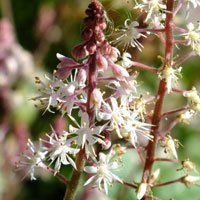
Foamflower (Tiarella spp.) is a fantastic and expertly-designed shade perennial plant prized for its beautiful foliage and how it looks. From North America came the Purple Coneflower, which is a perennial plant loved for its branchy shape and its leaves that are either dark purple or a light lavender color. In addition, resting being shade-tolerant, and the capability to takes root both in the woodland gardens as well as the borders and in container; foam flowers are most favored choices, which promotes the beauty and elegance of the gardens thereby adding the same to the shaded areas.
Majestic Features of Foamflower:
- Frothy Flower Clusters: Foamflowers do nice groundwork of the airy small composite flowers in white, pink or lavender shades, which sends out a tender and elusive look.
- Varied Foliage Colors: The distinction of foamflower encompasses a multitude of color in its foliage, from the deep violet to the burgundy and silver, filling shadows with life and brightness.
- Compact Growth Habit: A lot of Foamflower types has a great compact and mound form, therefore, they are good either for edging or borders, or for planting them near other shading plants.
- Long Blooming Period: The blooming period of the plant is extended, supporting the zenith of flower show and beauty in the garden in the time interval between spring and summer.
- Attracts Pollinators: The flowers of Foamflower will be a natural magnet for pollinators like bees and butterflies and together they will contribute to the diversity of the integrated garden ecosystem.
User-Friendly Features of Foamflower:
- Low Maintenance: Foamflower is lavishly carefree, needing only small care once it is rooted in the soil.
- Drought Tolerance: It becomes more drought-resistant once it is planted, making it an ideal choice when you don’t want to constantly water the plant.
- Shade Tolerance: These plants are mostly dependents on shaded environments, thus, they can grow in areas where other plants may suffer in growing properly.
- Deer and Rabbit Resistant: Shade tolerant and browsing resistant by their nature, foamflower can be placed in gardens for the promotion of wildlife.
- Container Compatibility: It is quite a fit for container gardening which suits both shadowy patios and balconies as well as indoors. It provides great color and texture.
Irritating Features of Foamflower:
- Susceptibility to Root Rot: Disorders on roots of Foamflower often occur in extremely wet soil. Thus, planting sites count to be well-drained.
- Limited Spread: Unlike other perennials, Foamflower often remains in clumps and may not expand as vigorously, hence the need for more plants for wider or larger areas.
- Occasional Pest Issues: What also needs to be considered is that the Foamflower is mostly pest resistant, but it may be a suitable habitat for the aphids or slugs in case of conducive conditions.
- Sensitive to Overwatering: Attending to the Foamflower needs takes some time and it can not be overwatered as it can cause fungal diseases and root rot in Foamflower.
- Dormancy Period: Some cultivars of Foamflowers can, at times, enter a dormant phase when it is either wintertime or bad growing conditions, the foliage dying back to a bare stem in the period.
Conclusion:
Tiarella spp. is an excellent and very friendly species for shilling decades , provided that it’s planted in the place of shade rather than in the sun light. This patient gives an atmosphere of beauty with a condition of adaptability. It’s remarkable about this kind of flowers that they are easy-growing, and they can be even planted in a jar on the windowsill! However, gardeners should be aware of the possible flower diseases that are spreading very fast, such as root rot and other fungal diseases that make the flower very rarely spread. Through appropriate care and concern, Foamflower is going to mark its presence to the shaded sections of the garden from time to time for years, owning prolonged of satisfaction and pleasure.
Grand Conclusion:
To summarize, the shade purple leaf plants’ realm is like a colorful tapestry of botanical miracles where both class and resistance are spun into one and natural beauty is allowed to bloom in the cool embrace of shade. With the Coral Bells and the mesmerizing Foamflower, the enchanting plants have all what it takes to captivate your senses just by looking at there striking hues, exquisite foliages and elegant forms. From the gentle shade of leafy gardens, we step into a world that is bursting with life and the beauty of every blossom in that, every flower is telling a tale of class and grace. Let’s be glad that we get to seek and admire the splendor of shade purple leaf plants where we, not only find our creativity and calmness, but we also uncover all the beauty that our eyes could see.

